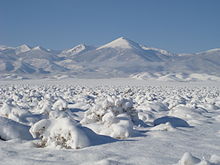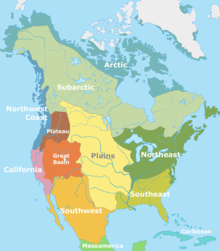Great Basin
The Great Basin (Spanish: Gran Cuenca) is the largest area of contiguous endorheic watersheds, those with no outlets to the ocean, in North America.The term "Great Basin" is applied to hydrographic,[3][4]: 11 biological,[3] floristic,[4]: 21 physiographic,[4]: 14 topographic,[3] and ethnographic geographic areas.[4]: 34 The name was originally coined by John C. Frémont, who, based on information gleaned from Joseph R. Walker as well as his own travels, recognized the hydrographic nature of the landform as "having no connection to the ocean".As observed by Fremont, creeks, streams, or rivers find no outlet to either the Gulf of Mexico or the Pacific Ocean.The region is bounded by the Wasatch Mountains to the east, the Sierra Nevada and Cascade Ranges to the west, and the Snake River Basin to the north.As it dried during the Holocene epoch, some species retreated to the higher isolated mountains and have high genetic diversity.Great Basin wildlife includes pronghorn, mule deer, mountain lion, and lagomorphs such as black-tailed jackrabbit and desert cottontail and the coyotes that prey on them.Exotic species, including chukar, grey partridge, and Himalayan snowcock, have been successfully introduced to the Great Basin, although the latter has only thrived in the Ruby Mountains.[20] The basin and range topography is the result of extension and thinning of the lithosphere, which is composed of crust and upper mantle.To the south are Cedar City, Tonopah, and Bishop and the very southern area of the basin has the communities of Pahrump, Palmdale, Victorville, and Palm Springs.[29] Archaeological evidence of habitation sites along the shore of Lake Lahontan date from the end of the ice age when its shoreline was approximately 500 feet (150 m) higher along the sides of the surrounding mountains.They hunted animals like mule deer and antelope and gathered onions, wild rye, and pinyon pine nuts.Unlike the Paleo-Indians, who moved around to follow bison herds, the Fremont built small villages and grew crops like corn and squash.[citation needed] European exploration of the Great Basin occurred during the 18th century Spanish colonization of the Americas.[31] Peter Skene Ogden of the British Hudson's Bay Company explored the Great Salt Lake and Humboldt River regions in the late 1820s, following the eastern side of the Sierra Nevada to the Gulf of California.[33] Around 1902, the San Pedro, Los Angeles and Salt Lake Railroad was constructed in the lower basin and Mojave Desert for California-Nevada rail service to Las Vegas, Nevada.Due to the region's altitude and aridity, most areas in the Great Basin experience a substantial diurnal temperature variation.







Great Divide BasinEndorheic basinMount WhitneySpanishendorheic watershedsNorth AmericaNevadaCaliforniaOregonWyomingBaja Californiabasin and range topographyBadwater BasinDeath Valleycontiguous United StatesphysiographicbiomesecoregionsdesertsGreat Basin DesertBasin and Range Geological ProvincehydrographicbiologicalfloristictopographicethnographicJohn C. FrémontJoseph R. WalkerNational Park ServicepanhandleGreat Basin ProvinceArmen TakhtajanSnake River PlainColorado PlateauUinta BasinArizonaMogollon RimBasin and Range ProvinceNevin FennemanUnited States Geological SurveyPhysiographic division of the United Statesindigenous peoples of the Great Basinclassification of indigenous peoples of the Americascultural regionList of Great Basin watershedsList of rivers of the Great BasinTule Valley watershedHouse RangeNotch Peakhydrologic unitGulf of MexicoPacific OceanWasatch MountainsSierra NevadaCascade Snake River BasinBaja California, MexicoGreat Salt LakePyramid LakeHumboldt SinkSalton SinkGreat Basin DivideLaguna SaladaBear RiverHumboldt Rivergroundwateraquifersgeographic sinksLake Tahoealpine lakeLahontanMojave DesertSnake ValleyMojaveColoradoSonoran DesertGreat BasinOregon HighJoshua treecreosote bushUtah junipersingle-leaf pinyonmountain mahoganypinyon-juniper woodlandlimber pinePinus longaevariparianPopulus fremontiiPopulus tremuloidesWorld Wildlife FundGreat Basin montane forestsLast Glacial PeriodHolocenehigher isolated mountainsEnvironmental Protection AgencyNorthern Basin and Range ecoregionCentral Basin and Range ecoregionMojave Basin and Range ecoregionpronghornmule deermountain lionlagomorphsblack-tailed jackrabbitdesert cottontailcoyotesPackratskangaroo ratsbighorn sheeplizardsGreat Basin fence lizardlongnose leopard lizardhorned lizardRattlesnakesgopher snakesInyo Mountains salamanderphalaropescurlewsAmerican white pelicansGolden eaglesMourning dovewestern meadowlarkblack-billed magpiecommon ravenendangered speciesCui-uisucker fish